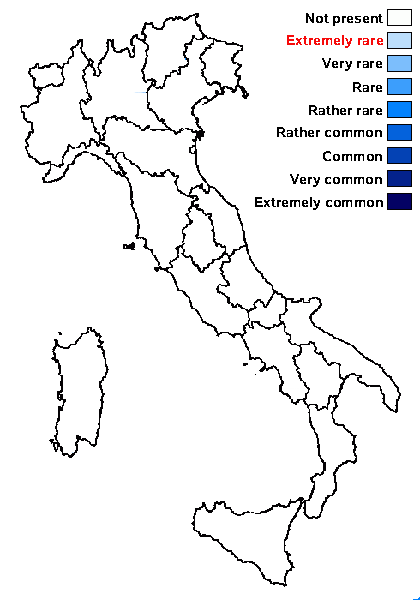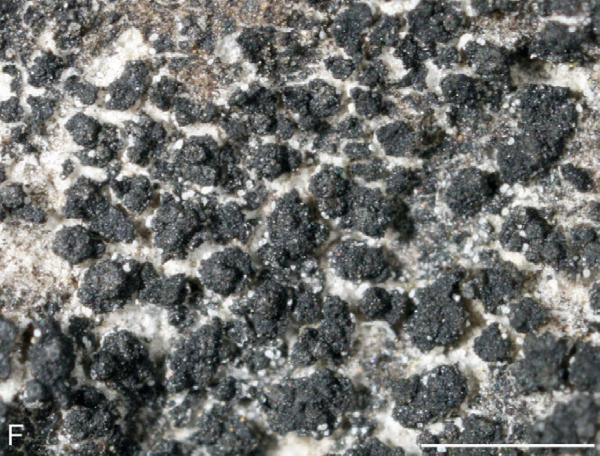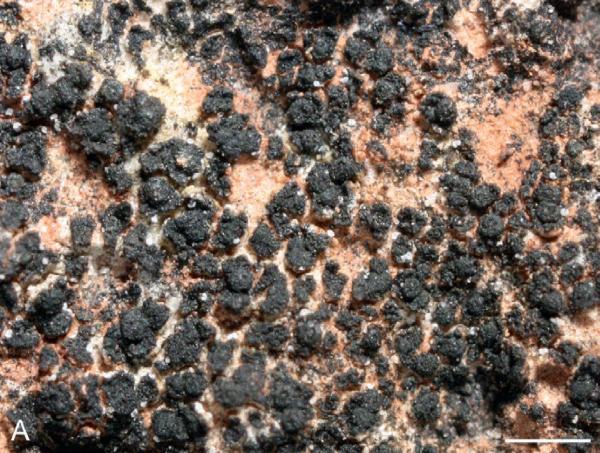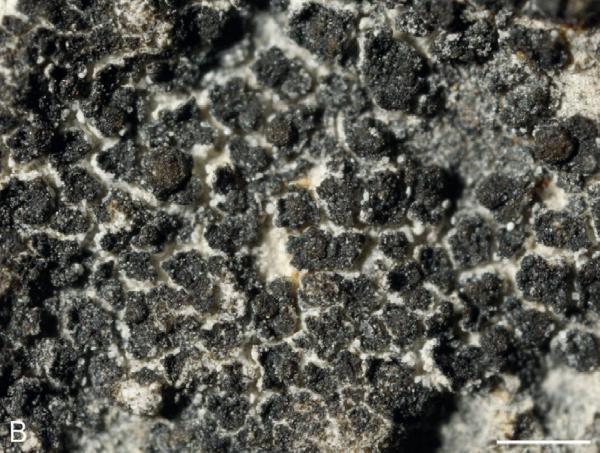Gonotichia octosporella (Lettau) M. Schultz & M. Prieto
in Prieto & al., Studies in Mycology, 109: 628, 2024. Basionym: Gonohymenia octosporella Lettau - Feddes Repert., Beih. 119, 5: 269, 1942.
Synonyms:
Distribution:
Description: Thallus crustose-areolate, blackish, granulose or consisting of areoles, these poorly delimited, (0.1.)0.2-0.3 mm wide, thin or swollen when fertile, attached by rhizohyphae, forming up to 2 cm wide patches. Upper cortex absent, the thallus homoiomerous, more or less paraplectenchymatous, the hyphae forming an irregular network around the cyanobionts. Apothecia thallinocarps, developing from free ascogones, up to 0.25 mm across, more or less hidden in the thallus, with an initially convex, then flattened, black disc and a flat and indistinct thalline margin. Proper exciple absent; hymenium colourless, 60–65 µm high, covered by sparse patches of sterile thalline plectenchyma with sparse photobionts, K/I+ yellowish-red slowly turning blue; paraphyses scarce, septate, becoming branched and anastomosing. Asci 8-spored, prototunicate, with an amyloid outer cap, Peccania-type. Ascospores 1-celled, hyaline, small, broadly ellipsoid to subglobose, 5-8.5 x 5-6.7 μm. Photobiont cyanobacterial, chroococcoid, with yellowish brown gelatinous sheaths. Spot tests: all negative. Chemistry: without lichen substances.Note: an apparently very rare, but perhaps overlooked species growing on intermediate rocks, such as calciferous sandstone, calciferous shosts or siliceous limestone (Kieselkalk) in sites with periodical water seepage. Described from Germany and also known from the Alps (France, Switzerland); to be looked for in Italy.
Growth form: Crustose
Substrata: rocks
Photobiont: cyanobacteria, coccaceous (e.g. Gloeocapsa)
Reproductive strategy: mainly sexual
On otherwise dry surfaces with short periods of water seepage after rain

Predictive model

Source: Prieto M., Wedin M., Schultz M. 2024. Phylogeny, evolution and a re-classification of the Lichinomycetes. Studies in Mycology, 109: 595-655. - CC BY-NC-ND
Gonotichia octosporella, crustose, areoles irregular, some with thallinocarps resembling gall like swelling (Schultz 05576b). Scale bar = 1 mm.

Source: Prieto M., Wedin M., Schultz M. 2024. Phylogeny, evolution and a re-classification of the Lichinomycetes. Studies in Mycology, 109: 595-655. - CC BY-NC-ND
Areoles with small, gall like thallinocarps (Prieto SL28). Scale bar: 1 mm

Source: Prieto M., Wedin M., Schultz M. 2024. Phylogeny, evolution and a re-classification of the Lichinomycetes. Studies in Mycology, 109: 595-655. - CC BY-NC-ND
Areoles with slightly lifted margins and some thallinocarps
(Prieto SMP137). Scale bar: 0.5 mm
Growth form: Crustose
Substrata: rocks
Photobiont: cyanobacteria, coccaceous (e.g. Gloeocapsa)
Reproductive strategy: mainly sexual
On otherwise dry surfaces with short periods of water seepage after rain

Predictive model

Source: Prieto M., Wedin M., Schultz M. 2024. Phylogeny, evolution and a re-classification of the Lichinomycetes. Studies in Mycology, 109: 595-655. - CC BY-NC-ND
Gonotichia octosporella, crustose, areoles irregular, some with thallinocarps resembling gall like swelling (Schultz 05576b). Scale bar = 1 mm.

Source: Prieto M., Wedin M., Schultz M. 2024. Phylogeny, evolution and a re-classification of the Lichinomycetes. Studies in Mycology, 109: 595-655. - CC BY-NC-ND
Areoles with small, gall like thallinocarps (Prieto SL28). Scale bar: 1 mm




